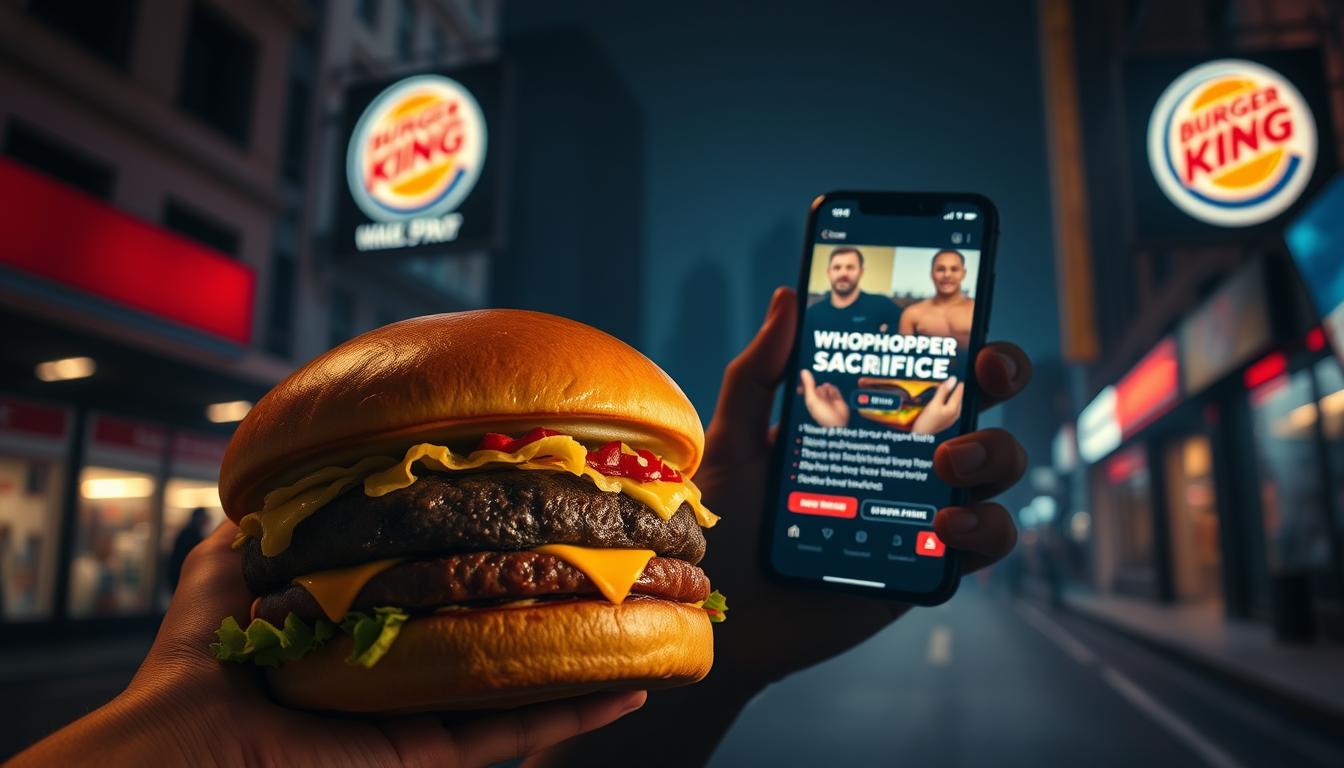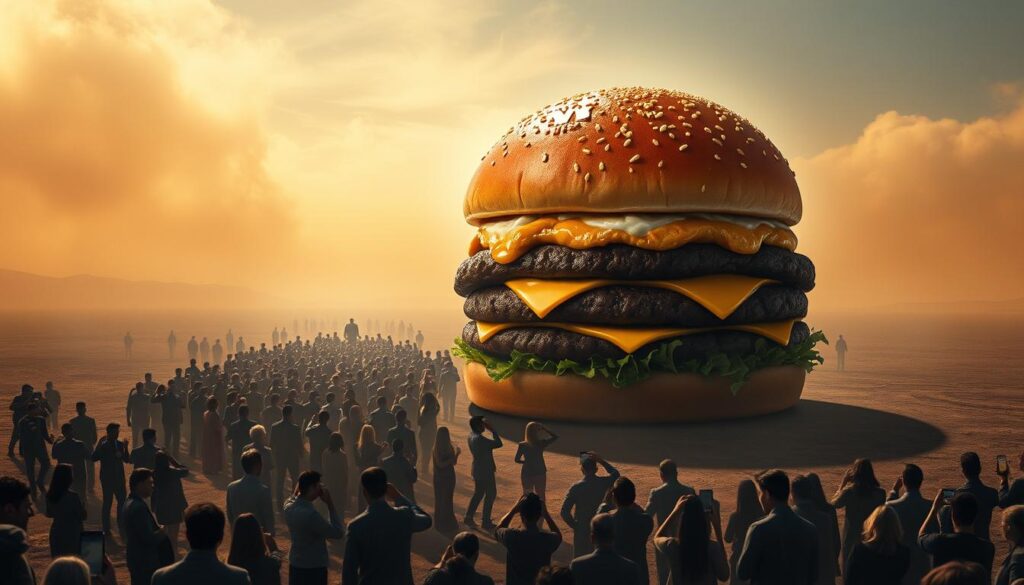
Imagine a marketing stunt so bold that it made tens of thousands of people willingly sacrifice their online friendships for a free meal. Welcome to the infamous Whopper Sacrifice campaign, a controversial yet brilliant move by Burger King that took social media by storm.
In 2009, Burger King dared Facebook users to delete 10 friends in exchange for a coupon for a free Whopper. The campaign was simple yet provocative: the more friends you sacrificed, the more Whoppers you could earn. Over 230,000 friendships were severed in just ten days, making it one of the most talked-about marketing efforts of the time.
This campaign wasn’t just about free food; it was a clever experiment in human behavior and consumer psychology. By integrating directly with Facebook’s interface, Burger King sparked a national debate: what’s more valuable, a friendship or a free Whopper? The campaign’s viral success can be attributed to its ability to blend humor, controversy, and a touch of rebellion.
For marketers, the Whopper Sacrifice serves as a key case study in viral marketing and social media advertising. It’s a reminder that sometimes, the boldest ideas are the ones that leave the most lasting impact. In this article, we’ll dive deeper into how this campaign redefined the boundaries of online engagement and what lessons it holds for modern marketers.
E-commerce SEOstrategies can learn a lot from this approach. By understanding what drives consumer interaction, brands can create campaigns that resonate just as powerfully.
Overview of the Whopper Sacrifice Campaign
In 2009, Burger King and the advertising agency Crispin Porter + Bogusky launched a bold experiment called the Whopper Sacrifice. This campaign challenged Facebook users to delete 10 friends in exchange for a free Whopper coupon. The idea was simple yet controversial, sparking widespread attention and debate.
Campaign Background and Launch
The campaign was part of a series of promotions centered around the iconic Whopper sandwich. It was designed to resonate with social media users by blending humor and rebellion. The application, which users had to install on Facebook, tracked the number of friends deleted. For every 10 friends removed, users earned a coupon for a free Whopper.
Integration with Social Networks and Facebook Interface
The campaign’s success lay in its seamless integration with Facebook’s design. The application looked like a natural part of the platform, making it easy for users to participate. Every interaction, from friend deletion notifications to automated campaign invitations, contributed to its viral spread. The campaign’s simplicity was its strength, making the sacrifice concept easy to communicate.
Each sacrificed friend received a notification explaining they were chosen over a Whopper. This added a layer of engagement, as those notified would often visit the application to learn more. The campaign quickly gained traction, with nearly 60,000 installations in just a few days.
| Category | Details |
|---|---|
| Campaign Duration | Approximately 8 weeks |
| Participations in 10 Days | 233,906 people sacrificed |
| Whopper Coupons Distributed | 20,000 |
| Facebook Friends Deleted | Over 200,000 |
The campaign’s viral mechanics and social media influence will be explored in more detail in the next section. For now, it’s clear that the Whopper Sacrifice campaign was a groundbreaking experiment in online engagement and consumer psychology.
Learn more about the campaign’s origins and impact in this detailed oral history.
Exploring the Viral Mechanics and Social Media Influence
The Whopper Sacrifice campaign harnessed the power of social media in a way that was both innovative and controversial. By creating an application that seamlessly integrated with Facebook, Burger King turned a simple idea into a viral sensation.
The Role of User Interaction and “Friend” Deletion
At the heart of the campaign was a bold premise: delete 10 Facebook friends, and get a free Whopper. This interactive design made users active participants, not just passive observers. The act of deleting friends became a statement, sparking conversations across social networks. Each deletion sent a notification, amplifying the campaign’s reach and creating a ripple effect that kept it in the public eye.

The simplicity of the application was key. It looked and felt like a natural part of Facebook, making participation effortless. This deceptive simplicity, as noted by Crispin Porter + Bogusky, led to rapid adoption and quickly strained Facebook’s network dynamics.
Impact on Social Networking Dynamics
The campaign sparked a national debate about the value of online friendships versus real-world connections. Users were incentivized to remove friends, leading to a reevaluation of social media relationships. This shift highlighted the tension between connectivity and privacy, challenging conventional social networking norms.
The campaign’s success can be attributed to its ability to blend humor with controversy, creating a sense of rebellion. For marketers, it serves as a landmark case study, demonstrating how to balance viral appeal with potential backlash. The integration of immediate user feedback, such as automated notifications, further amplified its impact, making it a memorable and engaging experience.
Media and marketing professionals viewed the campaign as a groundbreaking experiment in consumer psychology. The simple prompt—delete friends for a Whopper—led to complex social consequences, showcasing the power of innovative design in engaging users while disrupting norms.
Learn more about the psychological aspects of such campaigns in this study on consumer behavior and explore how search engine optimization strategies can enhance viral marketing efforts.
Burger King Whopper Sacrifice Campaign: Impact, Controversies, and Marketing Insights
The Whopper Sacrifice campaign sparked intense debates and left a lasting impact on marketing strategies. By encouraging users to delete Facebook friends for a free Whopper, Burger King created a bold experiment that blending humor with controversy.
Creative Strategy and ‘Whopper Love’ Messaging
The campaign’s core idea was simple yet provocative: exchange 10 friends for a free Whopper. This concept, dubbed “Whopper Love,” challenged users to question the value of online friendships. The strategy cleverly tapped into the desire for something tangible—a free meal—over digital connections, making it relatable and engaging.
Controversies, Privacy Issues, and Facebook’s Reaction
The campaign’s viral nature led to significant backlash. Public notifications of friend deletions sparked privacy concerns, with many users feeling uncomfortable about the transparency. Facebook eventually shut down the campaign for violating its terms of service, highlighting the risks of aggressive marketing tactics on social platforms.
| Category | Details |
|---|---|
| Participants in 10 Days | 233,906 people |
| Whopper Coupons Distributed | 20,000 |
| Facebook Friends Deleted | Over 200,000 |
Marketing Success and Expansion of Brand Awareness
Despite the controversy, the campaign was a marketing triumph. It generated massive press coverage, amplifying Burger King’s brand visibility without a substantial media budget. The strategy showcased how bold advertising could drive engagement and discussion, even with minimal resources. Learn more about the campaign’s success and its impact on marketing credentials.

Conclusion
The Whopper Sacrifice campaign stands out as a bold experiment in social media marketing, offering valuable lessons for brands today. By encouraging users to delete friends for a free meal, Burger King sparked a national debate on the value of digital friendships versus real-world rewards.
The campaign’s success lay in its ability to redefine how brands interact with consumers on social platforms. It challenged traditional notions of online relationships, creating a memorable experience that blended humor with controversy. The strategy, centered around the “Whopper Love” concept, became a benchmark for viral marketing.
Despite its innovative approach, the campaign faced significant backlash. Privacy concerns and Facebook’s intervention highlighted the risks of disruptive marketing tactics. However, the campaign’s impact on brand visibility and consumer engagement was undeniable, generating massive media buzz and over 200,000 friend deletions.
For marketers, this case study underscores the importance of balancing creativity with ethical considerations. It shows how risky strategies can shape brand identity and drive engagement, even if they spark controversy. As you explore more about innovative marketing strategies, remember that bold ideas can leave a lasting impact—both positive and negative.

 Burger King’s ‘Whopper Sacrifice’: How a Controversial Campaign Went Viral
Burger King’s ‘Whopper Sacrifice’: How a Controversial Campaign Went Viral
0 Comment